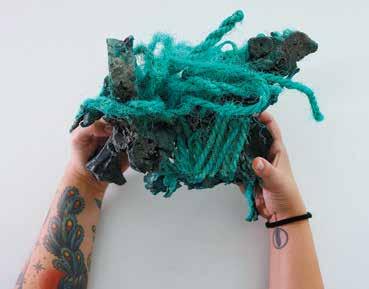
4 minute read
Herbs and Spices Promote Gut Health
A 2022 research study published in The Journal of Nutrition suggests that herbs and spices may be unsung heroes in the quest for gut health. The three-period, randomized, controlled-feeding study involved 54 obese or overweight adults aged 30 to 75 with at least one other risk factor for cardiovascular disease, such as elevated glucose or triglycerides.
Participants consumed the same average American diet for four weeks, along with one of three daily doses of spices and herbs—0.5 grams, 3.3 grams or 6.6 grams—which included cinnamon, ginger, cumin, turmeric, rosemary, oregano, basil and thyme. Fecal samples were collected at the start of the study and the end of each diet period.
Researchers determined that consuming 3.3 or 6.6 grams of herbs and spices per day increased levels of the Ruminococcaceae bacteria, a major player in the maintenance of gut health. The highest levels of this beneficial bacteria were observed among those that consumed the highest levels of herbs and spices. The scientists recommend further investigation to identify the metabolic implications of their findings.
Daily Intense Activity Prolongs Life
A new study in the journal Nature Medicine suggests that short bursts of intense movement are associated with a lower risk of premature death. The UK researchers analyzed data from about 25,000 non-exercisers with an average age of 62 that wore movement tracking devices on their wrists.
Vigorous intermittent lifestyle physical activity (VILPA) refers to short, sporadic bursts of exertion done as part of daily living, such as walking very fast while commuting to work or climbing stairs. The scientists found that compared to participants that engaged in no VILPA, those that did just one to two minutes of VILPA three to four times daily exhibited a 38 to 40 percent lower risk of death over the course of seven years. They also noted that just a few minutes of VILPA throughout the day reduced cardiovascular disease-related mortality by up to 49 percent.
Similar results were obtained when they analyzed vigorous physical activity in roughly 62,000 participants that exercised regularly. VILPA in non-exercisers appears to elicit similar effects to vigorous physical activity in exercisers, suggesting that VILPA may be a suitable physical activity target, especially in people not able or willing to exercise on a regular basis.
Microplastics Released by Tea Bags

Most mesh tea bags are made of 20 to 30 percent plastic, which can release microplastics and nanoplastics, causing harmful effects for both human health and the environment. In a study published in the journal Environmental Science & Technology, researchers found that one standard tea bag made with plastic released 11.6 billion microplastics and 3.1 billion nanoplastics into a cup of tea. The particles in the tea matched the nylon and polyethylene terephthalate in the original tea bag.
jatupronAdobeStock.com
Open Letter to Pause AI Experiments
A group of leading technology executives, researchers, academics and others from around the world have signed an open letter prepared by the Future of Life Institute calling for a six-month pause on large, human-competitive artificial intelligence (AI) experiments. As of March 31, more than 1,800 CEOs and 1,500 professors had signed the letter.

“AI labs are locked in an out-of-control race to develop and deploy ever more powerful digital minds that no one— not even their creators—can understand, predict or reliably control,” the letter contends. The authors are concerned that “AI systems are now becoming human-competitive at general tasks.”
While AI systems grow more powerful, there is no natural law or barrier to technical progress. The letter’s authors and signers are asking all AI labs to pause the training of powerful AI systems so that safety protocols can be implemented to ensure the effects of these systems will be positive and the risks manageable. According to the letter, “If such a pause cannot be enacted quickly, governments should step in and institute a moratorium.”
Individuals can view and sign the letter at Tinyurl.com/ AImoratorium.
Safer alternatives include steeping loose teas with a stainless steel or silicone tea strainer, or purchasing tea from brands that offer plastic-free teabags. Organic teas may still have plastic in the tea bag, as the packaging is not overseen by organic-certifying organizations.
Plastic Rocks Found on Remote Brazilian Island
Brazilian researchers have discovered rocks formed from plastic debris in the permanently preserved area of Trindade Island, approximately 680 miles off the coast of Brazil. The island is a remote refuge for green turtles, which come by the thousands every year to lay their eggs. The only human inhabitants of the island are members of the Brazilian navy.
The team of researchers ran chemical tests on the rocks, called plasticglomerates, and determined that they were formed when fishing nets were dragged by the current and accumulated on the beach. It is believed that the nets melt when the temperature rises and they become embedded with the sedimentary granules and other debris on the beach.

Dramatic Drop in Arctic Ice Levels
New research published in the journal Nature has found dramatic changes in the composition of sea ice in the Arctic Ocean since 2007 caused by climate change. Norwegian Polar Institute researchers have monitored sea ice thickness in the Fraim Strait (a sea channel connecting the Arctic Ocean and the Nordic Seas that runs between Greenland and the Norwegian archipelago) for the past three decades. In 2007, a “regime shift” was noted in Arctic sea ice composition, from thicker and deformed to thinner and more uniform ice cover.
Researchers found that the amount of thick and deformed ice had dropped by half, and they believe the thinning may be irreversible. They link the ice thinning to a rise in Arctic surface temperatures, more energy absorption because of a reduction in reflected light off the sea ice and warmer ocean water. Younger, thinner ice could result in a loss of habitat for Arctic creatures, as thicker, ridged sea ice can be a haven to hide from predators. There are also consequences for humans. Thinner, more level ice is less challenging for ship navigation and, along with less ice and shorter ice seasons, may permit an increase in Arctic maritime traffic.










